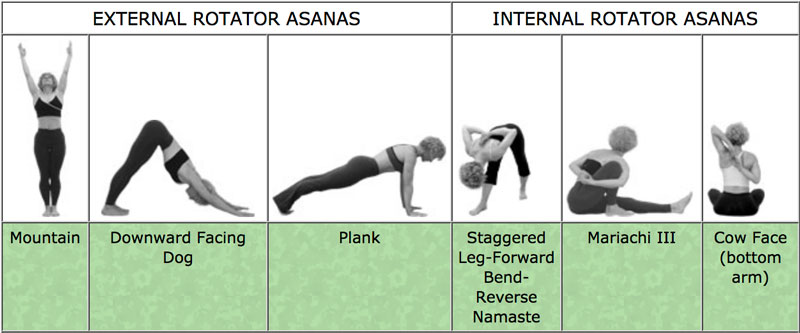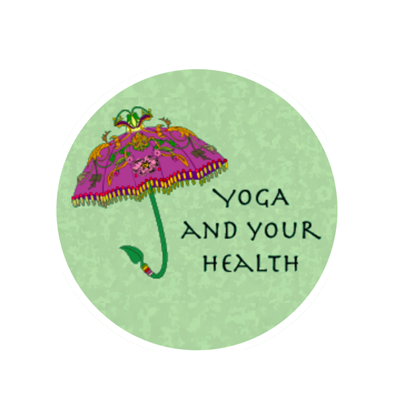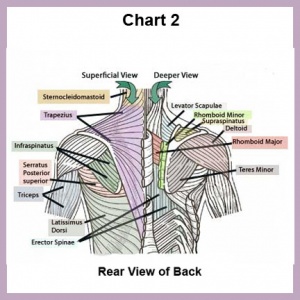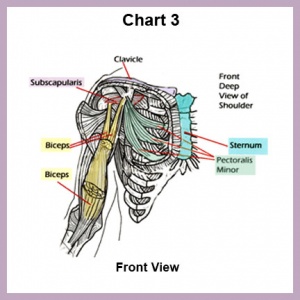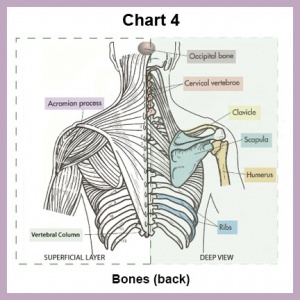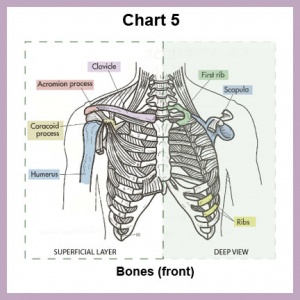Rotator Cuff
ROTATOR CUFF
(Scroll down or over to see Charts 1-5)
Let’s examine the components of the rotator cuff. The humerus (upperarm bone) Chart 1, has a rounded head. The outer side of the head forms the greater turberosity and the inner side is rounded and fits into the dish-like joint called the glenoid cavity of the scapula bones (scapulae are the wing-like bones in the upper back).
There are 4 muscles which comprise the Rotator cuff:
The supraspinatus, which keeps the head of the humorus from sliding down and out of the shallow joint of the glenoid cavity. It originates on top of the scapula. It makes abduction possible. [An example of abduction is moving the arm from Mountain Pose to Warrior II Pose.]
The infraspinatus and teres minor (Chart 2) work together to keep the ball of the humerus from impinging on the acromium (Chart 5) when lifting your arms from Warrior II to overhead. When you slump, the shoulder heads sink forward and cause the head of the humorus to squeeze up against the acromium process.
This habitual squeezing from a slumping habit causes exaggerated curvature and over lengthening of the back muscles. The back muscles, rhomboids, lats, trapezius, erector spinae, serratus posterior, and levator scapula become weaker and more likely to tear. If the teres minor and the infraspinatus are not strong enough to hold the humerus firmly in place, and the scapulae are not in proper alignment, then the tissue between the acromium process and the head of the humerus compress (Impingement Syndrome). (Chart 5)
The subscapularis (Chart 3) is an extremely strong internal rotator and its actions oppose those of the infraspinatus and teres minor. [Opposing muscles help each other keep proper alignment and protect against movement into unsafe ranges of motion.] Pockets of spacer pads called bursa run between bones and the tendons (tendons connect your muscle to bone).
If the pinching in the rotator cuff is creating damage to the bursa, it’s called bursitis and if it affects the tendon, its called tendonitis or RCT (rotator cuff tendonitis). There are groups of tendons, ligaments (ligaments connect bone to bone) and muscles that work as an elaborate strapping system, holding the head of the humerus in place while at the same time allowing for the most complex ranges of motion required by the shoulder joint.
There should be a balance between the flexibility/openness of the chest and the strength of the back muscles.
If you are beginning your yoga journey with weak, pre-injured or deconditioned shoulders remember to work in all ranges of motion with your shoulders. Allow your body to slowly re-learn proper alignment and postural balance. If a yoga asana that requires bearing the weight of your whole body on your arms, practice at the wall first. You can do wall plank, wall chaturanga, wall downward dog and wall push-ups (puppy-dog pose) to strengthen the upper arms and shoulder girdle area. Work gradually into full arm balances such as crow and handstand.
The important muscles to stretch: pec major and minor (Chart 3), lat dorsi, teres major, subscapularis, and anterior deltoids (Chart 2). Fish posture is a good pose to stretch the anterior delts.
It is necessary to maintain a 3:2 ratio between the strength of the external rotator and the internal rotator muscles. Practice standing at a wall in mountain pose, pressing your scapula into the wall while letting the inside crease of your elbow face forward (in the same direction as your nose), while lifting your sternum (Chart 3) upward without lifting your clavicle bones (Chart 5) or shoulder heads.
General guidelines for strength are rapid, controlled repetitions with lighter weights. Due to the slow twitch type 1 fibers of the SITS muscle group, external rotators have lower endurance and fatigue quickly. HGH (human growth hormone) levels are activated with higher reps with shorter rest periods between sets with much lighter weight.
Do shorter lever movement in the beginning stages of rehabilitation as it requires only moderate strength (i.e., use a narrow grip while doing a supine chest press). Avoid upright rows, tricep dips and supine tricep pullovers if you are working with an injured rotator cuff.
Below are some yoga postures which use the external rotators and the internal rotators.
